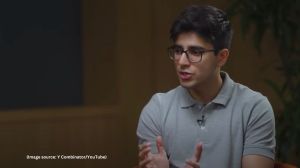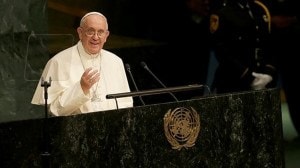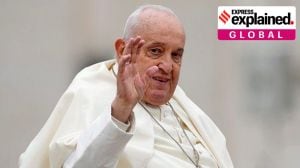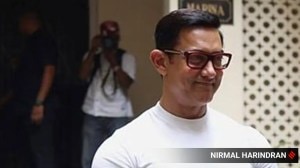David Coleman Headley: the 26/11 conspirator who got away with his life
Headley alias Daood Gilani struck a bargain with the US authorities, buying freedom from extradition to India in return for pleading guilty to all charges brought against him and cooperating with the prosecutors. He had been on the radar of investigators for long, and his ties with the Lashkar were likely known to US officials, according to investigating reporting on his role
 David Headley was born in Washington DC to a Pakistani father and American mother. (File)
David Headley was born in Washington DC to a Pakistani father and American mother. (File)While Tahawwur Hussain Rana is in the custody of the National Investigation Agency (NIA) in New Delhi, his closest collaborator during the 2008 Mumbai terrorist attacks, David Coleman Headley alias Daood Gilani, is serving time in prison in the United States.
Rana was extradited from the US on Thursday (April 10) evening. Headley had struck a bargain with the US authorities long ago, buying freedom from extradition to India in return for pleading guilty to all charges brought against him and cooperating with the prosecutors.
Headley was arrested at O’Hare International Airport in Chicago on October 3, 2009. According to prosecutors, he was headed to Philadelphia, intending to ultimately travel to Pakistan to deliver surveillance videos to top operatives of the Lashkar-e-Taiba and al-Qaeda.
In March 2010, Headley pleaded guilty to all 12 counts that were brought against him. In his testimony to federal officials, Headley said that the Mumbai attacks were a joint operation of the terrorist group Lashkar-e-Taiba (LeT) and Pakistan’s Inter-Services Intelligence Directorate (ISI).
On January 24, 2013, Headley was sentenced to 35 years in prison for federal crimes relating to his role in planning the 26/11 attacks and a subsequent, ultimately foiled, plot to attack the offices of the Jyllands-Posten daily newspaper in Copenhagen, Denmark.
This is his story.
Daood Gilani, a man who straddled two worlds…
Headley was born Daood Sayed Gilani in Washington DC in 1960 to Salim Sayed Gilani, a Pakistani diplomat and broadcaster, and Alice Serrill Headley, then a secretary at the Pakistani embassy in the US capital.
Headley was a months-old baby when his parents and two siblings moved to Lahore, Pakistan. He was an unusual-looking Pakistani boy, with pale skin and heterochromatic eyes – one blue and one brown.
After his parents divorced and his mother left Pakistan, Headley stayed on in the country with his father and his extended family. His father worked for long with Radio Pakistan, and ultimately died in December 2008, the month after the Mumbai attacks. His mother too, died in the same year, in the US.
Headley went to private military schools, including Cadet College Hasanabdal, the first quasi-military boarding school in Pakistan, located about 50 km to the northwest of Islamabad. It was at Hasanabdal in the 1970s that he met, and became close friends with, Tahawwur Rana.
When he was 17 years old, Headley returned to the US and was admitted to Valley Forge Military Academy and College in Philadelphia. He left after just one semester, and soon plunged into a world of crime and drugs. “After an upbringing characterized by discipline and limited contact with the opposite sex, Headley made up for all the things he’d missed in a big way,” wrote Flemming Rose in ‘The Tyranny of Silence: How One Cartoon Ignited a Global Debate on the Future of Free Speech’ (Cato Institute, 2014).
In the 1980s, Headley became addicted to drugs, and after a bar his mother ran in Philadelphia shut down, he moved with her to New York City, and opened two video stores in Manhattan. He kept travelling to Pakistan to smuggle heroin into the US. He was arrested by the US Drug Enforcement Administration (DEA) twice, in Germany in 1988 and in New York in 1997.
He cooperated with the authorities in both cases, ending up with relatively light prison terms, delivered some of his customers to law enforcement, and ultimately became, in the late 1990s, a DEA asset and informant, according to reported articles on his career trajectory as a terrorist collaborator.
In late 2001, “with America still licking its wounds in the wake of 9/11, Headley traveled to Pakistan, where by his own account he paid his first visit to a training camp run by the terror organization Lashkar-e-Taiba (LeT)”, Rose wrote.
Over subsequent visits to the country, which were occasionally unsupervised, Headley’s association with the LeT deepened, and he reportedly met Hafiz Saeed, the founder and leader of the terrorist organisation.
According to reporting by journalist and novelist Sebastian Rotella in ProPublica, the independent nonprofit investigative journalism newsroom, Headley’s ties with the Lashkar likely developed with the knowledge of US officials, who were presumably trying to get him to infiltrate the terrorist group.
According to court documents cited in Rotella’s 2010 report for ProPublica, Headley attended five LeT training camps over three years, where he learned about ideology, firearms, combat, counter-surveillance, and survival skills. He was valued for his knowledge of Urdu and English, which allowed him to blend in, while he trained more rigorously than Western recruits.
The ProPublica report mentioned Headley’s role in infiltrating “the very close-knit Pakistani narcotics dealing community in New York,” and of his travels to Pakistan “to develop intelligence on Pakistani heroin traffickers”. This agreement lasted until 2003 or 2005, according to an unnamed federal official who spoke to ProPublica.
…To David Coleman Headley, LeT’s man on the ground
In late 2005, with the Lashkar actively preparing for the attack on Mumbai, Headley received orders to conduct surveillance in India, according to a 2013 release by the US Department of Justice (DoJ).
In February 2006, Daood Gilani legally changed his name to David Coleman Headley in Philadelphia, which allowed him to “portray himself in India as an American who was neither Muslim nor Pakistani”.
Between 2006 and 2008, Headley visited Mumbai on five extended trips, according to the DoJ release — in September 2006, February and September 2007, and April and July 2008. His old friend Tahawwur Rana helped him by opening a branch of Rana’s American immigration consultancy firm in Mumbai.
On each trip to India, Headley recorded videos of potential targets, surveilled locations of interest, and assessed security measures. He reported back to Pakistan, where he met with LeT members, according to a 2013 Justice Department press release on his arrest.
His fourth trip in April 2008 focused on identifying potential landing sites for the terrorists who would travel to Mumbai from Pakistan by boat. He himself took boat trips around the harbour, using a GPS device to identify the precise coordinates for various locations for the landing.
In March 2009, months after the terrorist attacks, Headley made a sixth trip to India. This was to conduct additional surveillance, including that of the National Defence College in Delhi, and of Jewish Chabad Houses in several cities, according to the 2013 DoJ release.
American authorities had had an idea of Headley’s links to suspected terrorist activity from at least 2005. His American wife at the time, who had filed a domestic complaint against him, tipped off federal investigators about his links to LeT. In December 2007, Faiza Outalha, a Moroccan woman whom he had married, informed officials at the US embassy in Pakistan about Headley’s role in a possible terror plot in Mumbai.
But the American federal agencies did not act on this information. Officials who spoke to Rotella said Headley’s status as an informant helped him evade detection as he travelled between Mumbai to Pakistan, allowing him to game the system.
However, the US did send a series of warnings to India about a potential terror plot in Mumbai.
The first of this was in early 2008, which offered general intel about a potential LeT strike. In May, US officials identified the Taj Mahal Hotel and neighbouring sites frequented by tourists as potential strike sites. Then, on November 18, a week before the attack, they flagged a suspicious vessel posing a maritime threat to Mumbai.
How Headley evaded extradition to India
Given the familiarity of intelligence operatives with Headley’s activities over several years, it would seem odd that he evaded arrest for almost a year after the Mumbai attacks, the reporting suggests.
His role as a conspirator in two terrorist plots would have made him eligible for the death penalty in Illinois. Headley moved, therefore, to make himself indispensable to the investigation by opting for his usual strategy of cooperating.
His testimony revealed the extent of the LeT’s operations in Pakistan and the role of the Pakistani state intelligence in executing 26/11. This was reflected in the April 2011 indictment, which named Sajid Mir, a LeT leader and Headley’s handler, as well as Major Iqbal, purportedly an ISI official, for their roles in the 26/11 attack.
Headley’s 2010 plea agreement said that he “provided substantial assistance to the criminal investigation, and also has provided information of significant intelligence value”.
The only 26/11 terrorist who was caught alive, Ajmal Amir Kasab, was executed in 2012. The fate of Tahawwur Rana remains to be seen.
More Explained
Must Read
EXPRESS OPINION
Apr 22: Latest News
- 01
- 02
- 03
- 04
- 05


 The quasi-spherical shaped Aryabhata. (Photo: Isro)[/caption]
Though Isro was established near Thiruvananthapuram considering its proximity to the equator – for conducting experiments during the formative years – the very presence of the sea nearby and the recurrent salt water splashes prevented the setting up of the quintessential instrumentation or clean room facilities for space activities in Kerala’s capital.
Speaking to The Indian Express, Kale said, “That is when it was decided to shift the activities to Bangalore, which offered close proximity to institutions like the Hindustan Aeronautics Limited (HAL), along with a conducive environment supported by the presence of industries.
The Isro Satellite Systems Project was established at Peenya village, once known as Asia’s largest chain of small and medium-scale industries producing engineering and electronics goods.
Designing and building Aryabhata
U R Rao, credited with developing India’s satellite technology, led a 200-member team of engineers and scientists who went on to build Aryabhata at Peenya. Designed with 26 sides and weighing 358 kg, the spacecraft’s quasi-spherical shape was unique. Aryabhata included three scientific experiments: for X-ray astronomy, for observing solar neutrons and gamma rays, and one for studying the upper atmosphere.
The quasi-spherical structure caught the attention of locals in Peenya. S Radhakrishnan, 72, who worked at a factory in Peenya in the 1970s, said, “Every working day, my colleagues and I would walk past the shed ‘A’ (where Isro teams worked) to reach our industry located in shed ‘C’. On some occasions, the Isro engineers would be seen flying some objects and on others, performing some tests or experiments, but we had no clue what they were up to.”
He also mentioned another memory with regard to Aryabhata: catching a glimpse of the then prime minister Indira Gandhi, who had made multiple trips to Bangalore, inspecting Aryabhata at crucial stages ahead of its launch. “Upon learning that the prime minister was visiting, I took some time off duty to catch a glimpse of Indira Gandhi,” Radhakrishnan recalled.
Underneath the shed in Peenya, several first-of-its kind infrastructural facilities – the electronics laboratories, clean room for the final assembly of the satellite, thermal laboratories, control and stabilisation laboratories, antenna testing facilities, a workshop and draughting sections – were set up.
For nearly 30 months, the Isro teams worked for the development of the satellite’s prototypes and testing of the multiple models, ensuring that the highest reliability was achieved. Some of these tests included qualification in a thermo-vacuum chamber, vibration and shock tests. The satellite model was even taken up in a helicopter over Sriharikota during January 1975, kept almost stationary at various distances and altitudes from the ground station and the two-way communication link between the satellite and the ground telemetry station at Sriharikota was checked under simulated power levels of the transmitters.
[caption id="attachment_9953121" align="alignnone" width="600"]
The quasi-spherical shaped Aryabhata. (Photo: Isro)[/caption]
Though Isro was established near Thiruvananthapuram considering its proximity to the equator – for conducting experiments during the formative years – the very presence of the sea nearby and the recurrent salt water splashes prevented the setting up of the quintessential instrumentation or clean room facilities for space activities in Kerala’s capital.
Speaking to The Indian Express, Kale said, “That is when it was decided to shift the activities to Bangalore, which offered close proximity to institutions like the Hindustan Aeronautics Limited (HAL), along with a conducive environment supported by the presence of industries.
The Isro Satellite Systems Project was established at Peenya village, once known as Asia’s largest chain of small and medium-scale industries producing engineering and electronics goods.
Designing and building Aryabhata
U R Rao, credited with developing India’s satellite technology, led a 200-member team of engineers and scientists who went on to build Aryabhata at Peenya. Designed with 26 sides and weighing 358 kg, the spacecraft’s quasi-spherical shape was unique. Aryabhata included three scientific experiments: for X-ray astronomy, for observing solar neutrons and gamma rays, and one for studying the upper atmosphere.
The quasi-spherical structure caught the attention of locals in Peenya. S Radhakrishnan, 72, who worked at a factory in Peenya in the 1970s, said, “Every working day, my colleagues and I would walk past the shed ‘A’ (where Isro teams worked) to reach our industry located in shed ‘C’. On some occasions, the Isro engineers would be seen flying some objects and on others, performing some tests or experiments, but we had no clue what they were up to.”
He also mentioned another memory with regard to Aryabhata: catching a glimpse of the then prime minister Indira Gandhi, who had made multiple trips to Bangalore, inspecting Aryabhata at crucial stages ahead of its launch. “Upon learning that the prime minister was visiting, I took some time off duty to catch a glimpse of Indira Gandhi,” Radhakrishnan recalled.
Underneath the shed in Peenya, several first-of-its kind infrastructural facilities – the electronics laboratories, clean room for the final assembly of the satellite, thermal laboratories, control and stabilisation laboratories, antenna testing facilities, a workshop and draughting sections – were set up.
For nearly 30 months, the Isro teams worked for the development of the satellite’s prototypes and testing of the multiple models, ensuring that the highest reliability was achieved. Some of these tests included qualification in a thermo-vacuum chamber, vibration and shock tests. The satellite model was even taken up in a helicopter over Sriharikota during January 1975, kept almost stationary at various distances and altitudes from the ground station and the two-way communication link between the satellite and the ground telemetry station at Sriharikota was checked under simulated power levels of the transmitters.
[caption id="attachment_9953121" align="alignnone" width="600"] Assembly work in progress for Aryabhata in Bengaluru. (Photo: Isro)[/caption]
Tests were done on a balloon at 25 km in May 1973. The instruments for the scientific experiments, too, were tested and, lastly, the communication link was tested at 400 km, noted Rao in a 1978 research paper published by the Indian Academy of Sciences.
During the first quarter of 1975, the final fabrication phase of two flight models was completed along with the complete integration and testing of the actual flight model performed during the same period.
Simultaneously, in Bangalore, other ground-based support and tracking like the telemetry, telecommand and the communication units were being readied. The functioning of the entire ground station was tested using a helicopter-borne satellite model and simulating the transmitter power levels for the maximum range that the satellite will have during its orbit, to ensure that the ground station can receive the telemetered data from the satellite and send commands to the satellite.
A Mission Operations and Control Centre was set up at Peenya that would coordinate the commanding as well as data-gathering programme from various ground stations.
Even though all the three scientific experiments onboard Aryabhata had to be called off owing to power failure, other technological experiments were performed based on the use of the onboard telecommand, putting to use the transmitter-receiver for data transmission from one station to another using the satellite as a node.
Lasting impact
Today, half a century later, satellite-based communication is well-established and is being widely used, but its roots in India can easily be traced back to Aryabhata and Isro. The first voice transmission of a recorded speech was transmitted from Sriharikota to Bangalore via Aryabhata. Due to its high quality, another experiment involving electrocardiogram (ECG) signals was similarly transmitted – a demonstration of the opportunities and unlimited possibilities that satellite communication could offer in future. The India Meteorological Department in Pune assisted Isro in setting up a weather data gathering (wind speed, temperature, wind direction) platform from standard data collection points.
With over 12,000 electronic components, 20,000 solar cells and more than 25,000 interconnections within the satellite, Aryabhata was a demonstration of India's indigenous abilities to undertake the structural designing of a space-worthy satellite, fabricate and test it, develop thermal and power control systems as well as an entire ground station along with data processing systems.
Assembly work in progress for Aryabhata in Bengaluru. (Photo: Isro)[/caption]
Tests were done on a balloon at 25 km in May 1973. The instruments for the scientific experiments, too, were tested and, lastly, the communication link was tested at 400 km, noted Rao in a 1978 research paper published by the Indian Academy of Sciences.
During the first quarter of 1975, the final fabrication phase of two flight models was completed along with the complete integration and testing of the actual flight model performed during the same period.
Simultaneously, in Bangalore, other ground-based support and tracking like the telemetry, telecommand and the communication units were being readied. The functioning of the entire ground station was tested using a helicopter-borne satellite model and simulating the transmitter power levels for the maximum range that the satellite will have during its orbit, to ensure that the ground station can receive the telemetered data from the satellite and send commands to the satellite.
A Mission Operations and Control Centre was set up at Peenya that would coordinate the commanding as well as data-gathering programme from various ground stations.
Even though all the three scientific experiments onboard Aryabhata had to be called off owing to power failure, other technological experiments were performed based on the use of the onboard telecommand, putting to use the transmitter-receiver for data transmission from one station to another using the satellite as a node.
Lasting impact
Today, half a century later, satellite-based communication is well-established and is being widely used, but its roots in India can easily be traced back to Aryabhata and Isro. The first voice transmission of a recorded speech was transmitted from Sriharikota to Bangalore via Aryabhata. Due to its high quality, another experiment involving electrocardiogram (ECG) signals was similarly transmitted – a demonstration of the opportunities and unlimited possibilities that satellite communication could offer in future. The India Meteorological Department in Pune assisted Isro in setting up a weather data gathering (wind speed, temperature, wind direction) platform from standard data collection points.
With over 12,000 electronic components, 20,000 solar cells and more than 25,000 interconnections within the satellite, Aryabhata was a demonstration of India's indigenous abilities to undertake the structural designing of a space-worthy satellite, fabricate and test it, develop thermal and power control systems as well as an entire ground station along with data processing systems.
























